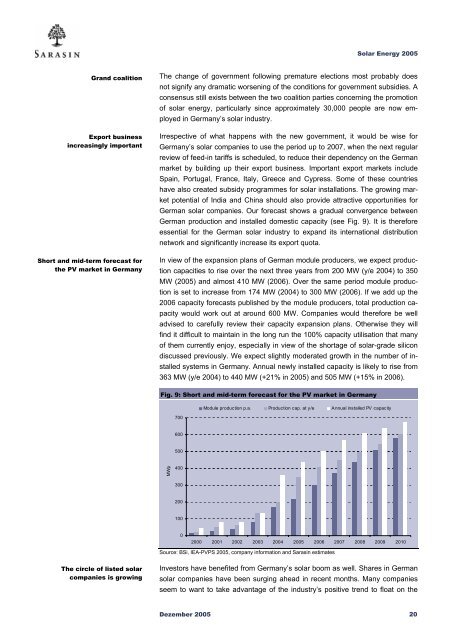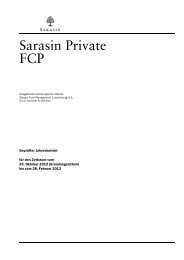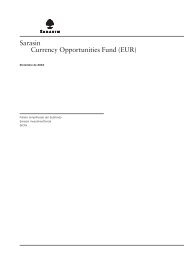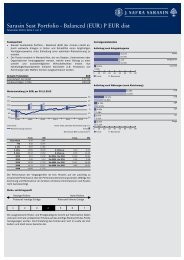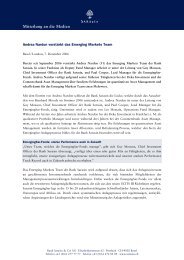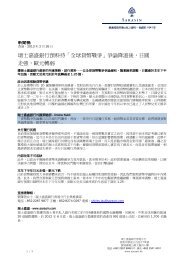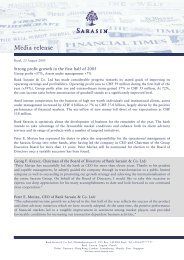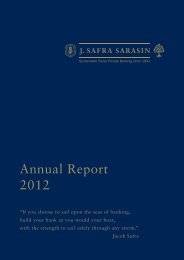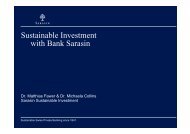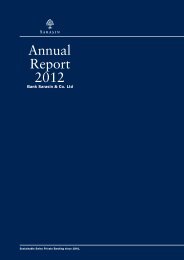Sustainability Report - Bank Sarasin-Alpen
Sustainability Report - Bank Sarasin-Alpen
Sustainability Report - Bank Sarasin-Alpen
Create successful ePaper yourself
Turn your PDF publications into a flip-book with our unique Google optimized e-Paper software.
Solar Energy 2005<br />
Grand coalition<br />
Export business<br />
increasingly important<br />
Short and mid-term forecast for<br />
the PV market in Germany<br />
The change of government following premature elections most probably does<br />
not signify any dramatic worsening of the conditions for government subsidies. A<br />
consensus still exists between the two coalition parties concerning the promotion<br />
of solar energy, particularly since approximately 30,000 people are now employed<br />
in Germany’s solar industry.<br />
Irrespective of what happens with the new government, it would be wise for<br />
Germany’s solar companies to use the period up to 2007, when the next regular<br />
review of feed-in tariffs is scheduled, to reduce their dependency on the German<br />
market by building up their export business. Important export markets include<br />
Spain, Portugal, France, Italy, Greece and Cypress. Some of these countries<br />
have also created subsidy programmes for solar installations. The growing market<br />
potential of India and China should also provide attractive opportunities for<br />
German solar companies. Our forecast shows a gradual convergence between<br />
German production and installed domestic capacity (see Fig. 9). It is therefore<br />
essential for the German solar industry to expand its international distribution<br />
network and significantly increase its export quota.<br />
In view of the expansion plans of German module producers, we expect production<br />
capacities to rise over the next three years from 200 MW (y/e 2004) to 350<br />
MW (2005) and almost 410 MW (2006). Over the same period module production<br />
is set to increase from 174 MW (2004) to 300 MW (2006). If we add up the<br />
2006 capacity forecasts published by the module producers, total production capacity<br />
would work out at around 600 MW. Companies would therefore be well<br />
advised to carefully review their capacity expansion plans. Otherwise they will<br />
find it difficult to maintain in the long run the 100% capacity utilisation that many<br />
of them currently enjoy, especially in view of the shortage of solar-grade silicon<br />
discussed previously. We expect slightly moderated growth in the number of installed<br />
systems in Germany. Annual newly installed capacity is likely to rise from<br />
363 MW (y/e 2004) to 440 MW (+21% in 2005) and 505 MW (+15% in 2006).<br />
Fig. 9: Short and mid-term forecast for the PV market in Germany<br />
700<br />
Module production p.a. Production cap. at y/e Annual installed PV capacity<br />
600<br />
500<br />
MWp<br />
400<br />
300<br />
200<br />
100<br />
0<br />
2000 2001 2002 2003 2004 2005 2006 2007 2008 2009 2010<br />
Source: BSi, IEA-PVPS 2005, company information and <strong>Sarasin</strong> estimates<br />
The circle of listed solar<br />
companies is growing<br />
Investors have benefited from Germany’s solar boom as well. Shares in German<br />
solar companies have been surging ahead in recent months. Many companies<br />
seem to want to take advantage of the industry’s positive trend to float on the<br />
Dezember 2005 20


